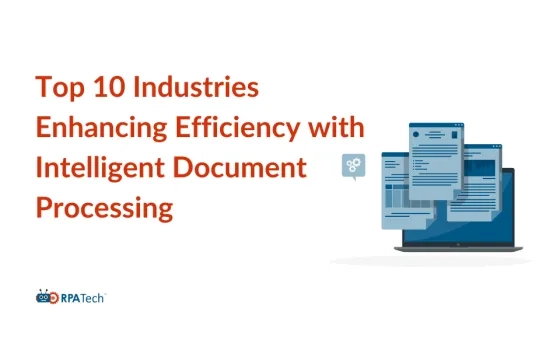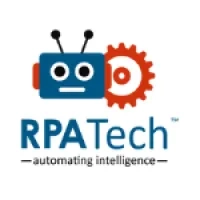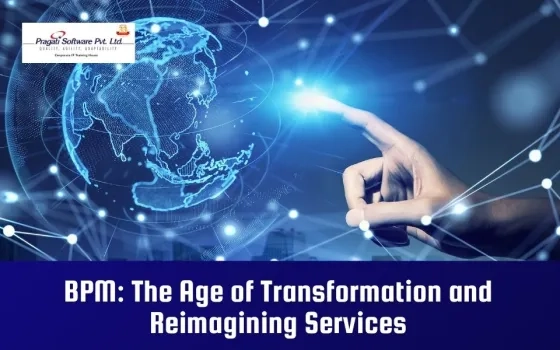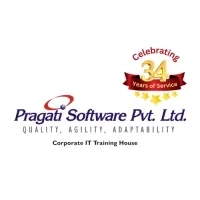Did you know businesses create a lot of data each year that's hard for regular spreadsheets to handle? In fact, 80%-90% of data in organizations is like this, making it tricky for businesses to use it effectively. This is where Artificial Intelligence (AI) can help. One AI solution is Intelligent Document Processing (IDP). It uses technologies like Optical Character Recognition (OCR), Computer Vision (CV), Natural Language Processing (NLP), and Machine Learning (ML) to manage and interpret this complicated data.
This blog post aims to help you understand:
- What Intelligent Document Processing is
- How Intelligent Document Processing Works
- Top 10 industries leveraging Intelligent Document Processing to enhance efficiency
So, let's begin with understanding what Intelligent Document Processing is.
What is Intelligent Document Processing (IDP)?
Intelligent Document Processing, or IDP, is a useful tool that helps businesses understand and use their data effectively. It takes all kinds of documents, even those without any specific format, and reads them like a human would. But it's much faster and more accurate.
It uses technologies like Optical Character Recognition (OCR), Computer Vision (CV), Natural Language Processing (NLP), and Machine Learning (ML). OCR reads text from images. CV helps computers see and understand images and videos like how humans do. NLP allows computers to understand sentences and texts like a human does. Machine Learning allows these tools to learn from experience without needing specific programming.
IDP uses these technologies to understand and organize all the information. It's especially useful in automating tasks like data entry and extracting important information from documents, which can save a lot of time and reduce errors. In short, IDP is a tool that helps businesses deal with all their paperwork in a smarter way.
How Does Intelligent Document Processing Work?
Companies use Intelligent Document Processing (IDP) to make sense of their large amounts of structured, semi-structured, and unstructured data. Unstructured data is information that doesn’t come in a fixed format, making it hard to analyze with traditional methods.
Some examples of unstructured data include customer feedback, market trends, brand reputation, reports, memos, contracts, etc. Text documents that hold valuable insights but lack a fixed format are also an example of unstructured data.
IDP solves this problem by using four key tools: Optical Character Recognition (OCR), Computer Vision (CV), Natural Language Processing (NLP), and Machine Learning (ML).
OCR technology is the first step in the process. It changes scanned documents into text that a computer can read. This also helps businesses in their efforts towards digitalization.
Computer Vision, or CV, is a technology that allows computers to ‘see,’ understand and analyze images and videos similar to how humans do.
Next, NLP helps understand the subtleties of human language in the text. This lets machines understand and analyze the context better.
ML is another tool, that helps to find patterns and clues in unstructured data. This lets businesses pull out important information with higher accuracy.
Here’s how Intelligent Document Processing (IDP) works.
- Data Ingestion: Initially, data is sourced from various places, such as emails or folders, and the format of the document is identified, whether it's PDF, PNG, JPEG, etc.
- Document Preprocessing: Next, IDP preprocess the document. This important step prepares the raw data for optimal data extraction. It involves cleaning and organizing the data to meet the requirements of Intelligent Document Processing or machine learning models. The goal is to improve document quality.
- Document Classification: Intelligent Document Processing sorts documents using preset rules or machine learning models. These models are trained to recognize document types such as invoices, purchase orders, legal documents, and patient records. This classification helps direct documents to their correct workflows.
- Data Extraction: Intelligent Document Processing solutions use OCR and CV to collect relevant data from documents. This applies to both structured documents such as forms, and unstructured ones like free-text documents.
- Data Validation: The data that has been extracted is checked for accuracy and consistency. Human oversight is maintained during this stage to confirm the validity of the data.
- System Integration: Intelligent Document Processing inputs validated data into the company's system. IDP can seamlessly integrate with other systems like content management platforms and enterprise resource planning (ERP) systems.
- Analytics & Reporting: Lastly, the data you pull can be studied to find insights. This includes spotting trends, noticing anomalies, and measuring performance.
By automating tasks like data entry, sorting documents, and pulling out information, IDP not only makes workflows smoother but also reduces mistakes and speeds up decision-making.
Therefore, Intelligent Document Processing (IDP) is a crucial tool for enhancing efficiency and enabling data-driven decision-making in the current digital era.
Top 10 Industries Leveraging Intelligent Document Processing (IDP) for Enhanced Efficiency
IDP is a rapidly growing market, attracting businesses from diverse sectors. Here is a list of the top 10 industries leveraging Intelligent Document Processing (IDP) to improve efficiency.
Banking and Finance
Banks and finance companies use Intelligent Document Processing (IDP) to automate tasks like loan approval, KYC procedures, managing identity documents, processing bank statements, managing invoices, and handling risk mitigation documents.
IDP pulls important data from various documents, making bank reconciliation and auditing faster and more accurate. This speeds up decision-making and improves efficiency.
The OCR solutions in IDP help detect fraud by automatically pulling and analyzing data from various documents. They identify and alert any patterns, discrepancies, or anomalies that could indicate fraud. This automated, accurate, and efficient process allows for early fraud detection and prevention.
IDP improves the customer experience by allowing for faster approvals and better data security through improved compliance measures. Its easy integration into banking systems leads to increased productivity and customer satisfaction in a highly competitive industry.
Insurance
Insurance companies use Intelligent Document Processing (IDP) for automating tasks like insurance claims, policy quotes, loss runs, and policy intakes. IDP's advanced OCR extracts and understands data from various documents, eliminating manual entry and hastening crucial processes like policy issuance and claim settlement. This efficiency not only expedites payments but also enhances customer service.
IDP serves as a robust tool for fraud detection by scrutinizing insurance documents for irregularities. By identifying suspicious claims early, insurers can mitigate risks and prevent financial losses. Overall, IDP revolutionizes traditional workflows, introducing speed, precision, and security to the insurance industry.
Healthcare
Healthcare industry is digitizing its paper records with Intelligent Document Processing (IDP). This tool is useful for a range of tasks including medical billing, insurance claim handling, and patient record management, making operations smoother and reducing staff workload.
IDP uses Optical Character Recognition (OCR) to pull data from medical documents automatically. This means that data is always correctly captured and follows the rules. It also makes mistakes less likely and keeps patient data safe, which improves trust and data security.
Transportation & Logistics
Transportation & logistics companies are digitizing shipping forms and customs paperwork using Intelligent Document Processing (IDP), leading to fewer manual errors and increased efficiency.
A key advantage of IDP in supply chain management is real-time visibility. Monitoring stock levels, delivery times, and order statuses allows companies to make informed decisions, utilize resources effectively, and identify potential issues early. This ensures smooth operations, even with changing demands.
IDP also makes billing and invoicing better by automating data extraction and checking. This reduces mistakes and disagreements, which helps build stronger relationships with stakeholders. It also improves financial management, speeds up payments, and helps to manage cash flow. This means greater efficiency and profits in the transport and logistics sector.
Manufacturing
Intelligent Document Processing (IDP) simplifies manufacturing tasks by digitalizing critical production documents and quality reports. It uses advanced technologies like Optical Character Recognition (OCR) to extract data from invoices, purchase orders, receipts, and forms automatically, reducing errors and enhancing efficiency.
Moreover, IDP efficiently manages resources, reduces unnecessary expenses, and ensures compliance with quality standards and regulations. This not only improves product quality but also boosts customer satisfaction. Additionally, it simplifies document management, thereby increasing the productivity and profitability of the manufacturing industry.
Government
Governments use Intelligent Document Processing (IDP) to enhance transparency and accountability, as digital records are easily accessible to the public. IDP streamlines government workflows by simplifying the storage, retrieval, and analysis of documents.
IDP extracts valuable data from documents to help data-driven decision-making. This enhances the efficiency of government agencies through automated data capture and analysis, improving adherence to regulations. By reducing mistakes and improving services, IDP is key in updating government operations, making them more efficient, transparent, and responsive to public needs.
Communication and Media
Intelligent Document Processing (IDP) in communication and media sector automates tasks such as processing licensing agreements, advertisement contracts, and royalty statements. This leads to time and cost savings, enhancing efficiency.
Optical Character Recognition (OCR) and Computer Vision (CV) extract valuable data from multimedia files, including videos, images, and audio recordings. This simplifies monetization of content, enhances viewer engagement, and enables effective rights management. It is revolutionizing content management in the communication and media industry.
Retail
Intelligent Document Processing (IDP) streamlines retail operations by automating tasks like invoice handling, purchase orders, and supplier contracts.
This automation boosts efficiency, minimizes errors, and saves time. Additionally, IDP provides real-time updates on stock management, including stock levels, demand trends, and supplier performance. This helps in preventing stock-outs and reducing carrying costs.
IDP accelerates order processing, return handling, and customer service, leading to quicker resolutions and increased customer loyalty. Overall, IDP improves retail operations and enhances the customer experience.
Utilities
Intelligent Document Processing (IDP) is revolutionizing utility company operations. Using OCR and CV, it extracts data from bills, meter readings, and service agreements. This speeds up processes and reduces errors, improving billing and metering accuracy.
IDP provides comprehensive reports on equipment performance, maintenance needs, and energy consumption. This enables more effective resource utilization, minimizes downtime, and enhances efficiency. Furthermore, IDP supports regulatory compliance, reducing the risk of penalties and promoting the company's financial stability.
Education
Intelligent Document Processing (IDP) simplifies office tasks in educational institutes. It automates tasks such as student enrollment, grading, transcript handling, and record management, freeing up time for teachers to concentrate on teaching.
OCR and CV extract valuable data from documents like research papers and articles, facilitating research, collaboration, and idea generation for teachers and students.
Conclusion
In conclusion, Intelligent Document Processing (IDP) is a transformative technology that is revolutionizing how businesses across various industries handle their data. From healthcare to transportation and logistics, from banking to education, IDP is streamlining operations, increasing efficiency, and contributing to better decision-making processes. By automating tasks and extracting valuable insights from unstructured data, it's clear that IDP is a game-changer in our increasingly digital world.



















